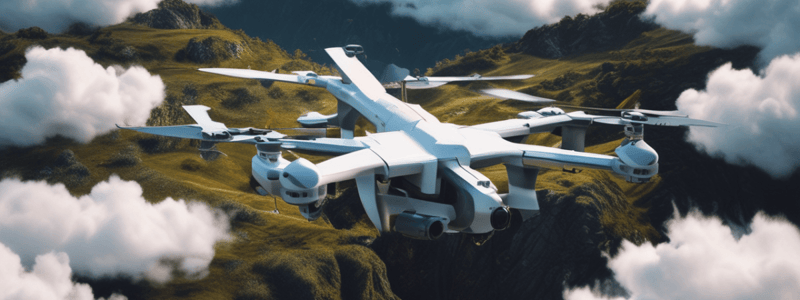Podcast
Questions and Answers
What is essential to ensure smooth shots while flying a drone?
What is essential to ensure smooth shots while flying a drone?
What is the purpose of performing a control sweep and battery test during takeoff?
What is the purpose of performing a control sweep and battery test during takeoff?
What is the primary goal of returning to home altitude (246) during flight?
What is the primary goal of returning to home altitude (246) during flight?
What is the key to creating a smooth orbit shot?
What is the key to creating a smooth orbit shot?
Signup and view all the answers
What is the recommended approach to improving smoothness during drone flight?
What is the recommended approach to improving smoothness during drone flight?
Signup and view all the answers
Study Notes
Acquiring Smooth Drone Shots
- To achieve smooth shots, use an ND filter and set up the tilt smoothly.
- Consider the director's or producer's requests, as they may dictate flight plans and paths.
- Flying super straight lines and slow speeds can help create smooth shots.
Rules of Takeoff
- Rule 1: Take off into the wind.
- Rule 2: Ensure the pilot and drone have the same orientation to avoid inadvertent motions.
- Rule 3: Perform a control sweep and battery test upon takeoff.
Safety Precautions
- Return to home altitude (246) for extra safety precautions.
- Monitor battery info and perform battery tests regularly.
Flight Motions
- Descend slowly while tilting up on the tilt wheel.
- Match speed with elevation to create smooth motions.
- Start recording before descending or elevating.
Shots and Techniques
- Descending Crane Shot: Descend while tilting up on the tilt wheel.
- Ascending Crane Shot: Elevate while tilting down on the tilt wheel.
- Upper Tilting Reveal: Tilt down slowly, then pitch forward and elevate.
- Histogram Shot (also known as Waveform Shot): Fly low over an object, then elevate and tilt up.
- Slide: Roll to the right, then elevate and tilt up.
- Rotating Reveal: Roll to the right, then yaw to the left, and elevate.
- Orbit: Roll to the right, yaw to the left, and elevate.
- Boomerang Shot: Combine an orbit with an upper tilting reveal.
- Obstacle Shot: Fly close to an obstacle, then reveal the surrounding area.
Tips and Tricks
- Practice makes perfect; don't be discouraged if shots don't turn out as expected at first.
- Consider flight paths, altitudes, and angles to add complexity and variation to shots.
- Use meditation, breathing exercises, or taking a walk to calm your hands and improve smoothness.
- Experiment with different focal lengths, altitudes, and angles to find what works best for your shots.
- Don't be afraid to get creative and try new things!
Acquiring Smooth Drone Shots
- Use an ND filter and set up the tilt smoothly to achieve smooth shots.
- Consider the director's or producer's requests to ensure flight plans and paths align with their vision.
- Flying super straight lines and slow speeds can help create smooth shots.
Rules of Takeoff
- Take off into the wind to ensure a safe and stable start.
- Ensure the pilot and drone have the same orientation to avoid inadvertent motions.
- Perform a control sweep and battery test upon takeoff to ensure all systems are functioning properly.
Safety Precautions
- Return to a safe altitude of 246 feet for extra safety precautions.
- Monitor battery information and perform regular battery tests to avoid unexpected landings.
Flight Motions
- Descend slowly while tilting up on the tilt wheel to create smooth motions.
- Match speed with elevation to create smooth and controlled motions.
- Start recording before descending or elevating to capture the full shot.
Shots and Techniques
- Descending Crane Shot: Descend while tilting up on the tilt wheel.
- Ascending Crane Shot: Elevate while tilting down on the tilt wheel.
- Upper Tilting Reveal: Tilt down slowly, then pitch forward and elevate.
- Histogram Shot (also known as Waveform Shot): Fly low over an object, then elevate and tilt up.
- Slide: Roll to the right, then elevate and tilt up.
- Rotating Reveal: Roll to the right, then yaw to the left, and elevate.
- Orbit: Roll to the right, yaw to the left, and elevate.
- Boomerang Shot: Combine an orbit with an upper tilting reveal.
- Obstacle Shot: Fly close to an obstacle, then reveal the surrounding area.
Tips and Tricks
- Practice regularly to improve smoothness and shot quality.
- Consider flight paths, altitudes, and angles to add complexity and variation to shots.
- Use meditation, breathing exercises, or taking a walk to calm your hands and improve smoothness.
- Experiment with different focal lengths, altitudes, and angles to find what works best for your shots.
- Don't be afraid to get creative and try new things!
Studying That Suits You
Use AI to generate personalized quizzes and flashcards to suit your learning preferences.
Description
Learn the basics of capturing smooth drone shots and essential rules for takeoff, including using ND filters and following flight paths.




